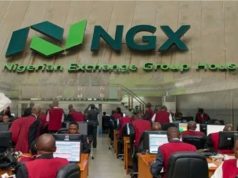…Exports to Spain, Nigeria’s second biggest trading partner was valued at N569.4 billion
MON, MARCH 18 2019-theG&BJournal-India was Nigeria’s major export market in Q4 2018 accounting for 15.5% (N780.1billion) of total exports, according to the latest data published today by the National Bureau of Statistics (NBS).
The largest export commodity to India was crude oil (N730.3billion). This was followed by Natural gas liquified (N39.1billion), Sesamum seed (N4.1 billion), Cashew nuts (N2.0billion) and others.
On the other hand, Nigeria imported Live purebred horses (N66.5billion), Live horses (N9.3billion), Primates (N6.8billion) and Other live mammals (N6.6billion) from India during the period under review.
China maintained its position as a major trading partner of Nigeria. In Q4 2018, Nigeria’s export trade with China was dominated by Natural Gas liquified which amounted to N63.4billion in value, followed by crude oil (N23.5billion), sesamum seed (N13.7billion), propane, liquified (N8.0billion) and butane, liquefied (N4.7billion).
In terms of imports, Machines for reception of voice, Motor Cycles, Machine tools for working stones, Amorphous PET chips and Machines for cleaning seeds worth N35.6billion, N19.9 billion, N18.9billion, N15.6billion and N14.2 billion respectively were imported from China.
Nigeria’s exports to Spain was valued at N569.4 billion making it the second largest export market for Nigeria in Q4 2018. Crude oil was the top Nigerian export during the period under review, valued at N471.6billion.
Other goods exported to Spain during the period were Natural Gas liquified valued at N93.1billion, Leather prepared after tanning (goat) (N2.1billion) and others.
In terms of imported commodities, Live purebred breeding horses valued at N295.2 billion, Live horses other than purebred valued at N285.9 billion, Primates valued at N283.4 billion and other Live mammals valued at N270.2 billion were imported from Spain.
In Q4 2018, Nigeria exported N432.2billion worth of crude oil to France. Other major export commodities include: Natural Gas Liquified valued at N62.1 billion and Technically-specified natural rubber valued at N0.6 billion. In terms of imports, the main commodity imported was Motor spirit, accounting for N36.5 billion.
Other imported products were Machinery for filling/closing/capsuling/labelling (N4.2billion) and Industrial air compressors (N3.6billion).
The Netherlands, a major export market of Nigeria in Q4 2018, accounted for 6.5% (N328.7billion) of total exports. Exports to the Netherlands was dominated by crude oil (N272.6billion). This was followed by other petroleum gases in gaseous state (N19.1billion), Good fermented Nigerian Cocoa Beans (N15.3 billion) and Superior quality raw Cocoa Beans (N7.1billion) and others. With respect to imports, Motor spirit valued at N143.2billion, Gas oil valued at N94.5billion, Other parts of gas turbine valued at N28.5billion were the major goods imported from the Netherlands.
Meanwhile, the All commodity group import price index rose 0.89% due to a rise in the prices of prepared foodstuffs following a 0.47% drop in November and a 1.36% rise in December.
The main drivers of the change in November were Raw hides and Skin (+4.0%),Live animals; animal products (+3.4%), Base metals and articles (+1.4%), as well as animals and vegetable fats (+1.3%). These were offset by decreases in Products of the chemical and Allied industries (-1.0%), Mineral product (-1.1%), Vegetable products (-1.3%) and foot wears, head gears etc(-2.1%).
In December 2018, the positive contributions of Prepared foodstuffs (+4.1%), Foot wears (+2.6%), Mineral products (+2.2%) and Products of the chemical and Allied industries (+1.8%) were also offset by negative trends in Vegetable products (-0.9%), Textiles and articles (-2.0%), Animal and Vegetable fats (-2.3%) and Raw hides and Skin (-2.9%).
The All commodity group export index recorded 106.2, 107.4 and 104.0 in October, November and December respectively. This represents an increase of 1.2% between October and November, but a drop of 3.2% between November and December. On average, there was a decrease of 2.02%. The decrease was led by falling prices of Vegetable products, Vehicles, aircraft and parts thereof and Products of the chemical and allied industries.
The All products terms of trade (TOT) index stood at 98.0 in October, 99.6 in November and 95.1 in December. This indicated an increase of 1.64% in November and a decrease of 4.48 % in December The All products terms of trade (TOT) index fell 2.8%, due to falling prices of Products of the chemical and allied industries, Mineral products, Live animals; animal products.
The product groups that contributed to the changes in November were: Base metals and articles of base metals (+3.8%), Wood and articles of wood, wood charcoal and articles (+2.4%) and Raw hides and skins, leather, furskins etc.; saddlery (+1.8%). These were offset by Products of the chemical and allied industries (-2.0%), Vehicles, aircraft and parts thereof; vessels (-3.0%) and Vegetable products (-3.3%).
However, in December 2018, prepared foodstuffs (+3.66%), Footwear, headgears (+1.9%), as well as Live animals; animal products (+1.6%) all had positive impacts on the All product (export) group. At the same time, the downward trend recorded in base metals and articles (-2.6%), Mineral products (-3.3%), Articles of stone, plaster, cement (-3.5%), among others, affected the overall performance of the All product group export index.
The All region group export index stood at 106.2 in October, an increase of 1.8% over the figure recorded in September. In November and December, it registered 107.5 and 104.0, representing an increase of 1.23% between October and November and a drop of 3.25% between November and December. Overall, the index recorded a drop of 2.02%, driven mainly by falling exports prices in Asia and within Africa.
The all region group import index stood at 108.4 in October, 107.9 in November and 109.2 in December. This indicates a decrease of 0.5% in November against the index recorded in October and an increase of 1.26% in December when compared with the value recorded in November.
Overall, the index recorded 0.76% increase during the quarter, driven by rising prices of imports from the Oceania region.
During the quarter, the All Region terms of trade registered 98.07 (October), 99.74 (November) and 95.27 (December). These indices show an increase of 1.7% in November compared with October, and a decrease of 4.48% in December against the level in November. On average, the terms of trade declined by 2.78% during the quarter driven by less favourable terms of trade within Africa.
|twitter:@theGBJournal|email: info@govandbusinessjournal.com.ng|









